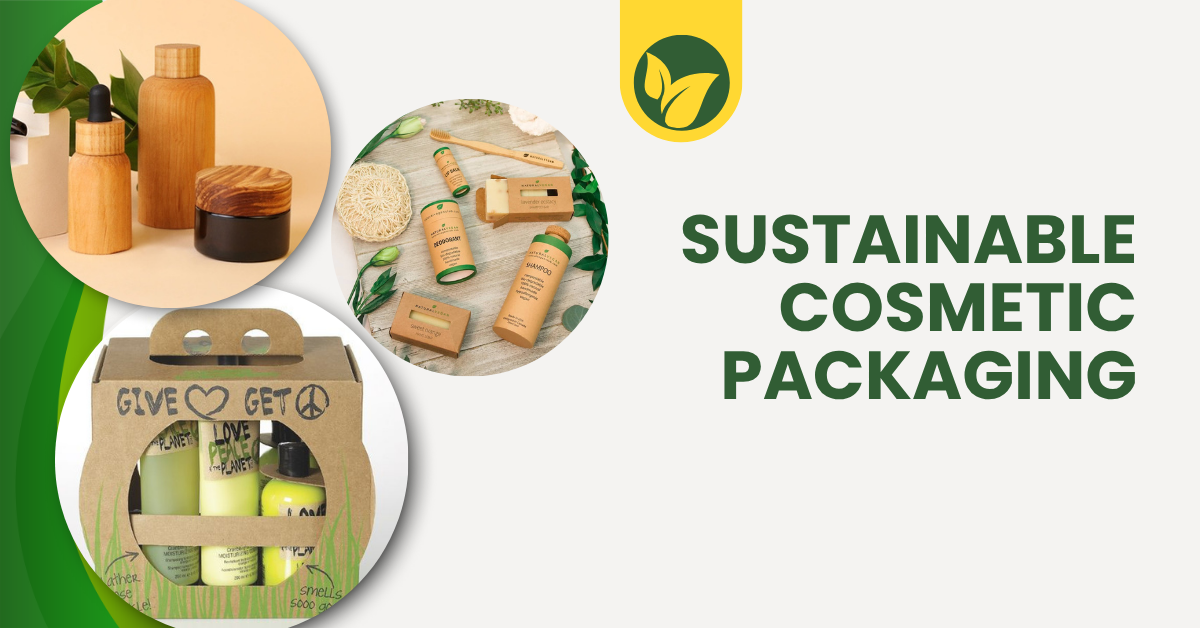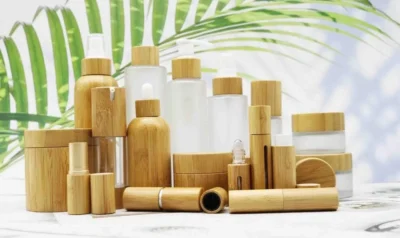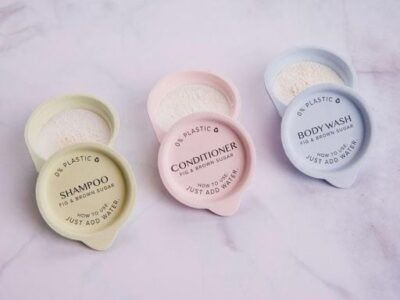Sustainable Cosmetic Packaging 2025

In 2025, sustainable cosmetic packaging is the cornerstone of the $532 billion beauty industry, where 68% of Gen Z and 55% of Millennials demand eco-friendly brands. Small businesses and e-commerce cosmetic brands are leading the charge, adopting green cosmetic packaging like seaweed pouches and bamboo jars to cut waste and win hearts. With the sustainable packaging market valued at $285 billion in 2024 (6.5% CAGR through 2030) and EU’s Packaging and Packaging Waste Regulation (PPWR) mandating 50% recyclable materials by 2030, sustainable cosmetic packaging is a must.
A UK Startup’s Seaweed Pouch Revolution
In Bristol, a small skincare brand called TideGlow faced a dilemma in 2024: their plastic serum sachets were alienating eco-conscious customers. Founder Emma Clarke discovered seaweed-based pouches—made from sodium alginate, a biodegradable algae extract—that dissolve in water, leaving zero waste. Switching to these sustainable cosmetic packaging solutions cost 15% more than plastic, but Emma negotiated with a local supplier for low-volume runs, saving 8%. By 2025, TideGlow’s pouches boosted sales by 20%, with 10,000 Instagram followers raving about their zero-waste cosmetic packaging for indie brands. Emma’s story shows how niche materials can transform a brand’s image.
For your brand, seaweed pouches are a bold green cosmetic packaging option. Source them from suppliers like Notpla, starting with 1,000-unit orders to test compatibility with your products (e.g., lightweight serums). Ensure ASTM D6400 certification for compostability and run stability tests to prevent leakage. Promote your sustainable cosmetic packaging with Instagram Reels showing the pouch dissolving in water—Emma’s reel hit 15,000 views, driving orders. Small businesses can stand out by embracing unique eco-friendly cosmetic packaging, turning eco-appeal into sales.
A Canadian Brand’s Bamboo Jar Breakthrough

In Vancouver, indie makeup brand LeafLush struggled with heavy glass compacts that spiked shipping costs. Founder Mia Patel switched to bamboo jars in 2024, sourced from a Fair Trade supplier in Southeast Asia. These lightweight, biodegradable jars cut logistics costs by 12% and aligned with LeafLush’s clean beauty ethos. Mia added engraved logos for a premium feel, boosting perceived value without extra waste. By 2025, LeafLush’s sustainable cosmetic packaging drove a 25% sales spike, with 8,000 X followers praising their biodegradable cosmetic packaging solutions 2025. Mia’s pivot shows how material swaps can save cash and build loyalty.
Small businesses can adopt bamboo for green cosmetic packaging. Contact suppliers like EcoBamboo for 500-unit minimums, ensuring FSC certification for sustainable sourcing. Test jars with your products (e.g., creams, powders) for durability and seal integrity. Add custom engravings for branding, keeping costs under $2 per unit. Share your sustainable cosmetic packaging story via a Medium post like “Why Bamboo Is Our Eco-Friendly Cosmetic Packaging Choice,” as Mia did, earning 3,000 views. Bamboo’s tactile appeal makes it a budget-friendly way to elevate eco-friendly cosmetic packaging for small brands.
A US Startup’s Compostable Pod Innovation

In Austin, skincare startup DewDrop faced backlash over single-use mask sachets in 2024. Founder Liam Torres partnered with a supplier to develop compostable pods made from PHA (polyhydroxyalkanoates), a plant-based plastic that degrades in home composters. Using an AI design tool, Liam optimized the pods for 30% less material, cutting costs by 10%. Launched in 2025, DewDrop’s pods sold out in 72 hours, with 70% of buyers citing the sustainable cosmetic packaging as their reason. Liam’s AI-driven cosmetic packaging design 2025 campaign on X gained 12,000 reposts, proving innovation drives buzz.
You can explore compostable pods for green cosmetic packaging. Platforms like PackSavvy offer AI design tools for $400/month, creating efficient sustainable cosmetic packaging like PHA pods. Start with 1,000 units, testing for product stability (e.g., no oil seepage). Ensure Cradle to Cradle certification for lifecycle sustainability. Promote your eco-friendly cosmetic packaging with X posts showing compost tests—Liam’s post hit 20,000 views. Small brands can use AI to create standout biodegradable cosmetic packaging solutions 2025, balancing cost and impact.
A Brazilian Brand’s Refill System Triumph

In São Paulo, indie brand SolVida saw customers ditching their plastic perfume bottles. Founder Ana Costa launched a 2024 refill program, offering sustainable cosmetic packaging through recycled glass vials. Customers ordered refills online and returned empties via prepaid mailers for sterilization, tracked by QR codes showing impact (e.g., “You saved 2 plastic bottles”). By 2025, 7,000 subscribers joined, cutting SolVida’s waste by 30%. Ana’s Instagram campaign, “Refill Your Scent, Save the Planet,” hit 25,000 engagements, showcasing circular cosmetic packaging systems as a loyalty driver.
Your brand can start a refill system for green cosmetic packaging. Partner with suppliers like Glassnow for recycled glass vials, starting at 500 units. Use QR codes to incentivize returns with 10% discounts, keeping logistics costs under 5%. Test one product, like Ana’s perfumes, to gauge demand. Share your sustainable cosmetic packaging via Instagram Stories, showing the refill process—Ana’s Stories boosted retention by 20%. Refills make eco-friendly cosmetic packaging for small brands a scalable, customer-centric solution.
Engaging Consumers with Green Cosmetic Packaging
Indie brands thrive by involving consumers in their sustainable cosmetic packaging journey. In 2024, London-based lip balm brand PurePout launched a “Shape Our Pack” contest, asking fans to design green cosmetic packaging via Instagram. Over 3,000 submissions included ideas like paperboard tubes and refillable tin cases. The winning tube design, launched in 2025, reduced waste by 35% and boosted sales by 15%. PurePout’s X thread on the contest hit 10,000 reposts, proving eco-friendly cosmetic packaging engagement builds community.
Run a similar contest for your sustainable cosmetic packaging. Use Typeform to collect fan ideas for zero-waste cosmetic packaging for indie brands, like compostable lip balm tubes. Reward winners with free products and test top designs with a supplier for feasibility. Share the process on X or Instagram, like “Help Us Design Our Next Green Cosmetic Packaging!”—PurePout’s post gained 5,000 followers. Co-creation cuts R&D costs and makes sustainable cosmetic packaging a shared mission, driving loyalty for small businesses.
Scaling Globally with Sustainable Cosmetic Packaging
New Zealand’s indie brand EcoBloom aimed for Asia-Pacific markets, where 40% of beauty sales occur. Facing China’s 2025 Green Packaging Law (60% recyclable materials), founder Zoe Kim adapted her sustainable cosmetic packaging with recycled PET tubes from a Shenzhen supplier. A 2024 Japan pilot using paperboard palettes cut shipping costs by 10% and boosted sales by 18%, as 70% of Japanese consumers prefer green cosmetic packaging. Zoe’s Medium post, “Our Eco-Friendly Cosmetic Packaging in Asia,” hit 4,000 views, driving pre-orders.
Go global with your sustainable cosmetic packaging. Research regulations via Export.gov—e.g., China’s law or EU’s PPWR. Source compliant materials, like recycled PET for Asia, starting with 1,000 units. Test market fit with a pilot, like Zoe’s in Japan. Promote your biodegradable cosmetic packaging solutions 2025 with multilingual X posts, like “Our Green Cosmetic Packaging Lands in Tokyo!” Zoe’s post gained 3,000 reposts. Global expansion amplifies your eco-friendly cosmetic packaging impact, growing revenue for small brands.
The 2035 Vision for Green Cosmetic Packaging
By 2035, sustainable cosmetic packaging could redefine beauty. Mycelium packaging—grown from mushroom roots in urban labs—may replace plastics, cutting waste by 50%. Global refill networks, tracked by blockchain, could save 100 million tons of packaging annually. AI might craft hyper-personalized green cosmetic packaging, like dissolvable pods matched to skin types. With 80% of beauty packaging projected to be circular (Ellen MacArthur Foundation), indie brands adopting eco-friendly cosmetic packaging now will lead. TideGlow’s seaweed pouches or SolVida’s refills are early steps toward this future.
Build your 2035 legacy with sustainable cosmetic packaging. Test emerging materials like mycelium from suppliers like Ecovative, starting with 500 units. Join circular programs like TerraCycle’s beauty initiative to share infrastructure. Use AI tools like PackSavvy for future-proof AI-driven cosmetic packaging design 2025. Share your vision via a Medium series, “Our 2035 Green Cosmetic Packaging Plan,” to inspire and gain backlinks. Small brands can shape the future of eco-friendly cosmetic packaging today.
Your Green Cosmetic Packaging Roadmap
-
Audit Impact: Use Ecochain to assess your packaging’s footprint.
-
Test Materials: Source seaweed pouches, bamboo jars, or PHA pods from suppliers like Notpla.
-
Launch Refills: Start a circular cosmetic packaging system with recycled glass vials.
-
Engage Fans: Host a contest for zero-waste cosmetic packaging for indie brands.
-
Go Global: Adapt green cosmetic packaging for markets like China or Japan.
-
Plan for 2035: Experiment with mycelium or AI-driven sustainable cosmetic packaging.
Timeline
-
Month 1: Audit packaging, contact suppliers.
-
Month 2: Test materials, launch fan contest.
-
Month 3: Pilot refills, use AI for eco-friendly cosmetic packaging designs.
-
Month 4: Enter one global market, promote on X/Medium.
-
Ongoing: Track waste reduction (20% goal) and sales (10% growth).
Metrics
Measure waste reduction, sales growth, and engagement. SolVida’s refills cut waste by 30% and boosted retention by 20%. Use Google Analytics for Medium traffic or Instagram insights for Reels views, targeting 5,000+ engagements.
FAQs
What is sustainable cosmetic packaging?
Green cosmetic packaging uses biodegradable or recyclable materials like seaweed or bamboo to reduce environmental impact.
Why prioritize eco-friendly cosmetic packaging in 2025?
Sustainable cosmetic packaging meets 68% consumer demand, saves 5-12% costs, and complies with PPWR regulations.
How can indie brands adopt green cosmetic packaging?
Source biodegradable cosmetic packaging solutions 2025 from suppliers, test small batches, and engage fans.
What are key sustainable cosmetic packaging solutions?
Seaweed pouches, bamboo jars, compostable pods, and refills drive eco-friendly cosmetic packaging.
How do refills enhance sustainable cosmetic packaging?
Circular cosmetic packaging systems reduce waste through reusable, trackable containers.
Conclusion: Lead with Sustainable Cosmetic Packaging
In 2025, sustainable cosmetic packaging is your chance to shine in the beauty industry. Indie brands like TideGlow, LeafLush, and SolVida show how zero-waste cosmetic packaging for indie brands, biodegradable cosmetic packaging solutions 2025, and circular cosmetic packaging systems win customers and cut waste. Start today—test a seaweed pouch, launch a refill program, or engage fans with a contest.